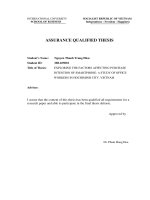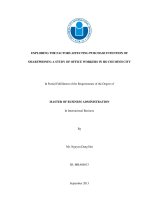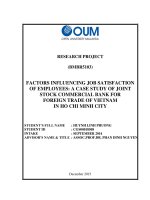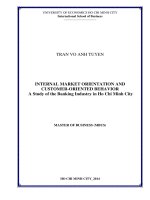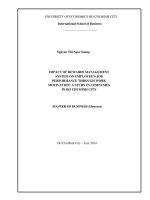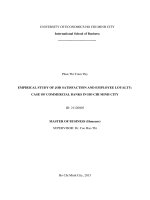Factors influencing consumer purchase intention a study private labels in ho chi minh city
Bạn đang xem bản rút gọn của tài liệu. Xem và tải ngay bản đầy đủ của tài liệu tại đây (1.44 MB, 88 trang )
UNIVERSITY OF ECONOMICS HO CHI MINH CITY
International School of Business
------------------------------
NGUYEN THI KIEU CHI
FACTORS INFLUENCING CONSUMER
PURCHASE INTENTION: A STUDY
PRIVATE LABEL IN HO CHI MINH CITY
MASTER OF BUSINESS (Honours)
SUPERVISOR: Dr.VO THI NGOC THUY
Ho Chi Minh City – Year 2015
TABLE OF CONTENTS
Table of Contents
ABSTRACT ..............................................................................................................................1
Chapter 1: INTRODUCTION .................................................................................................2
1.1 Research background .......................................................................................................2
1.2 Management problem.......................................................................................................3
1.3 Research problem.............................................................................................................4
1.4 Research objectives ..........................................................................................................5
1.5 Significance/value/implications ........................................................................................5
1.6 Research scope .................................................................................................................5
1.7 Research structure ............................................................................................................6
Chapter 2: LITERATURE REVIEW, HYPOTHESES AND RESEARCH MODEL..........7
2.1 Introduction......................................................................................................................7
2.2 Literature review ..............................................................................................................7
2.2.1 The concept of brand.................................................................................................7
2.2.2 The concept of private label ......................................................................................8
2.2.3 The differences between private labels and national brands.....................................10
2.2.4 The concept of consumer purchase intention ...........................................................12
2.3 Hypotheses development ................................................................................................13
2.3.1 Summary of existing research related to private label context .................................13
2.3.2 Perceived quality and consumer purchase intention .................................................16
2.3.3 Perceived risk, perceived quality and consumer purchase intention .........................18
2.3.4 Familiarity, perceived quality and consumer purchase intention ..............................22
2.3.5 Store image, perceived quality and consumer purchase intention ............................24
2.4 Research model ..............................................................................................................27
2.5 Conclusion .....................................................................................................................28
iii | P a g e
Chapter 3: RESEARCH METHODOLOGY .......................................................................29
3.1 Introduction....................................................................................................................29
3.2 Research procedure ........................................................................................................29
3.3 Research design .............................................................................................................29
3.4 Data collection method...................................................................................................30
3.4.1 Primary data ............................................................................................................30
3.4.2 Secondary data ........................................................................................................32
3.5 Product selection ............................................................................................................32
3.6 Measurement scales .......................................................................................................32
3.7 Sample size ....................................................................................................................35
3.8 Sampling ........................................................................................................................35
3.9 Data Analysis .................................................................................................................36
3.10 Conclusion ...................................................................................................................36
Chapter 4: DATA ANALYSIS AND RESULTS ..................................................................37
4.1 Introduction....................................................................................................................37
4.2 Data statistical analysis ..................................................................................................37
4.3 Measurement scales test and modifying .........................................................................39
4.4 Confirmatory Factor Analysis (CFA) result ....................................................................40
4.4.1 Model fit indices .....................................................................................................40
4.4.2 Saturated model ......................................................................................................41
4.5 Research model test........................................................................................................44
4.5.1 Theoretical model without moderating effect test by SEM ......................................45
4.5.2 Theoretical model with moderating effect test by SEM ...........................................47
4.5.3 Theoretical model test by Bootstrap ........................................................................50
4.5.4 Hypotheses testing ..................................................................................................51
4.6 Conclusion .....................................................................................................................53
iv | P a g e
Chapter 5: CONCLUSION....................................................................................................54
5.1 Introduction....................................................................................................................54
5.2 Research results: ............................................................................................................55
5.2.1 The results of measurement scale ............................................................................55
5.2.2 The results of theoretical model ..............................................................................55
5.3 Managerial implications .................................................................................................59
5.4 Limitations and directions for further research ...............................................................61
REFERENCES .......................................................................................................................63
APPENDICES ........................................................................................................................72
Appendix A: Interview Question ..........................................................................................72
Appendix B: Questionnaire ..................................................................................................73
Appendix C: Bảng Câu Hỏi Khảo Sát ..................................................................................76
Appendix D: Cronbach's Alpha Testing ..............................................................................79
Appendix E: Exploratory Factor Analysis ...........................................................................80
Appendix F: Standardized Regression Weights ...................................................................81
Appendix G: The SEM Result of Research Model With Moderating Effect ........................82
v|Page
LIST OF FIGURE
Figure 2.1 : The research model of private label proneness ..................................................... 16
Figure 2.2: The research model ............................................................................................... 28
Figure 3.1: Research procedure ............................................................................................... 31
Figure 4.1: Saturated model (Standardized estimates) ............................................................. 41
Figure 4.2: The SEM result of theoretical model without moderating effect (Standardized) .... 46
Figure 4.3: The SEM results of research model with moderating effect (Standardized) ........... 48
vi | P a g e
LIST OF TABLE
Table 3.1: Measurement scale and sources .............................................................................. 33
Table 4.1: Descriptive of statistics ........................................................................................... 38
Table 4.2 Cronbach’s Alpha, Composite reliability and AVE results ....................................... 42
Table 4.3: The correlation of research variables ...................................................................... 43
Table 4.4: Standardized estimates and p-value of hypothesized model .................................... 47
Table 4.5: The findings of regression weights in SEM model (Standardized) .......................... 49
Table:4.6 The results of indirect effects by bootstrap estimate (standardized) ......................... 50
Table 4.7: The results of BOOTSTRAP estimate .................................................................... 51
Table 4.8 : The results of hypotheses testing ........................................................................... 53
vii | P a g e
ABSTRACT
The appearance of private labels brings plenty of benefits for retailers and consumers
during the past period. Although this trend is much appreciated and successful in Western
countries, Asian buyers are not motivated to purchase private label due to the uncertain feeling.
Based on previous studies and findings, this research intends to investigate how several
predictors including financial risk, performance risk, physical risk, store image, familiarity
affect on perceived quality and consumer purchase intention towards private labels. Besides,
the mediating and moderating effects are also evaluated with the purpose of accessing deeply
knowledge about this brand extension strategy. The research model is designed to test in
HCMC retailing market with sample size being 380 participants and collected data is analyzed
by SEM method.
The results reveal that excepting financial risk, the other factors have significant meaning
in explaining the variance of dependent variables. Specifically, performance risk, physical risk
and store image influence remarkably on perceived quality and on purchase intention indirectly
whereas only direct effect of familiarity on purchase intention is fully proved. More
interestingly, the moderating role of store image, which modifies the relationship between
performance risk, physical risk and perceived quality, is strongly determined. Hence, store
image is considered as a symbol of quality and risk reducer. The research finding provides
useful reference for retailers and marketers to give effective strategies associated with private
labels. Among them, quality guaranty and maintaining store reputation and image must receive
more attention.
The current study also contains some limitations involving sample size, lack of diversity
on product category as well as measurement scale of store image, which need to evaluate
carefully. Thus, it is approval to fulfill these drawbacks by further research.
Keywords: Private labels, perceived risk, perceived quality, familiarity, store image, and
purchase intention.
1|Page
Chapter 1
INTRODUCTION
1.1 Research background
The harsh competition among business sector motivates company to apply their brand
strategies in order to survive and pursue clients. One of the efficient actions these firms employ
is the emergence of brand extension. By this, it is likely to develop their brand image in the
shoppers’ minds and achieve the customers’ loyalty as well.
With regard to retailing sector, nowadays more and more products with diverse categories
and brand names have been come into the supermarkets that create a dynamic competitive
environment. From that, not only manufacturers but also retailers have to set up novel mission
stressing the important ability to gain long-term profit and differentiating their products from
others rivals.
More seriously, the pressure of unfavorable economic condition and the rapid increasing
of living cost, most of consumers gradually change their shopping habits and become more
sensitive with the price these days. This is to say, while the shoppers try to spend less as little
as possible, they also indicate to seek higher quality from the products.
To deal with these difficulties, globally retailers start to produce products branded their
own name and sold in their stores, which are perceived as private labels. Actually, offering
private labels is considered as a smart strategy because of not only rising margin for themselves
but also attracting customers and gaining their customers' loyalty in an aggressive competition.
The more private label products are offered, the more customers have choices to evaluate and
purchase with the same quality but at lower price compared to national brand. Hence, this leads
to a new severe battle between retailers and producers.
In addition, according to a survey of AC Nielsen, 68% of 21,100 respondents in 38
markets from Europe, North American, Asia-Pacific to South Africa agree that supermarket
own brands are good alternatives to other brands (2005). Globally, private label penetration has
developed remarkably in Western Europe and North America. The US market has a value share
2|Page
of 79.1 billion dollars in 2012 and it is lower than that in Western Europe at 13%. Nevertheless,
the vast US consumers evaluate the quality of private labels as well as national brand whereas
they are perceived negatively in Asia Pacific, the Middle East and Africa (Euromonitor
International, 2013).
1.2 Management problem
The penetration of private label is appreciated and developed in most of the Western
countries and regions, however, Asian-Pacific consumers are still resisting in buying private
labels in spites of the promotional efforts (Sheau- Fen et al., 2012). The report of AC Nielsen in
2005 shows that market share of private label in this area is only 4%. Compared to some
nations, New Zealand and Australia are the two countries which have the highest rates of
private label market share whereas this number in others countries such as Thailand, Malaysia
or Vietnam is not significant.
Turning to Vietnam, even though the market size is quite smaller than other countries in
the same region, Vietnamese retailing market is still expected to have vast growth owing to the
large population, the majority of young generation in population structure, high economic
growth and the continuous improvement on residents’ living standard. It is evaluated as an
attractive destination of multinational retailing corporations. With regard to Ho Chi Minh Citythe biggest economic and commercial center, it has diverse distribution channels from
traditional markets, supermarkets to convenience stores that offer a variety of good categories,
quality and price. This distribution system not only provides better approach to attract and
serve customers, but also becomes one of competitive advantages of each retailer.
Compared to other distribution types, supermarkets account 30% in the first quarter of
2014 (Savills, 2014). In addition, consumers gradually change their habits into choosing
supermarkets or hypermarkets instead of traditional markets due to comfortable shopping
environment and the portfolios of products or brand names. From that, establishment and
development of this modern distribution channel in Vietnamese market is speculated in full
yield.
3|Page
Recognizing this potential, both international and domestic investors set up a range of
supermarkets in many cities in Vietnam. Considered as one of their empirical expansion
strategies, thus, recently they start to complement private label proneness. After the entry of
Metro Cash and Carry, private labels are introduced by other big supermarkets namely
Co.opMart, Big C and Vinatex Mart. These product categories often focus on fresh and
processed foods, household products and garments and receive heavy promotion such as price
and display. Moreover, private label products are the corporation of supermarkets and small
local manufacturers or farms, thus it help them solve output issue due to weak competitive
abilities with other strong brand names.
A survey including 305 participants of Vinaresearch in HCMC and Hanoi shows that 81%
of informants who have known and used to purchase private label products of supermarkets
because of attractive prices (2012). A paradox occurs that although Vietnam has the highest
promotion sensitivity in Asia at 87% and consumers gradually change their perception of
purchase more Vietnamese goods, the consumption of private labels is still not high as other
countries such as Thailand, Malaysia and Indonesia (Nielsen, 2011). This is because consumers
are lack of awareness of private labels as well as afraid of risk.
1.3 Research problem
With the potential growth of retailing market and the advantages of private label
penetration, the question raised by retailers and marketers is what reasons or key factors would
customers consider when they intend to buy private label products. In addition, though a
numerous studies especially brand strategy, market performance or buyer behavior have drawn
both marketing academics and managerial implications (Baltas, 2003; Dursun et al., 2001),
official studies about consumers purchase intention towards private labels in Vietnamese
context remain limited. Following prior studies conducted in many nations and some initial
investigations explored consumer attitude in Vietnamese market, the current study tries to
fulfill these gaps by measuring the relationships between several variables namely perceived
4|Page
risk, perceived quality, familiarity, store image and consumers purchase intention towards
private labels.
1.4 Research objectives
Based on these issues above, the overall objective of this study is to identify some key
factor affecting consumer purchase intention towards private labels. Specifically,
- To test the effect of financial risk, performance risk, physical risk and store image on
perceived quality.
- To test the indirect effect of financial risk, performance risk, physical risk and store
image on consumer purchase intention through perceived quality.
- To test the direct effect of familiarity on consumer purchase intention and the indirect
effect through perceived quality.
- To test the moderating role of store image, which modifies the relationship between
financial risk, performance risk, physical risk and perceived quality.
1.5 Significance/value/implications
This research intends to access and gain more knowledge about private label proneness
offered by supermarkets by measuring the significant role of financial risk, performance risk,
physical risk, perceived quality, familiarity and store image that consumers use to judge their
purchase intention. From the research finding, managers or marketers gain good understanding
of Vietnamese consumer behavior towards private labels in order to have appropriate decisions
and strategies to improve the product's standards, increase sales volume and enhance the
customer evaluation.
1.6 Research scope
The research focuses mainly on investigating consumers who usually shop in
supermarkets located in Ho Chi Minh City.
The period of collecting the data including qualitative and quantitative methods are
conducted from 4th August, 2014 to 15th of September, 2014.
5|Page
1.7 Research structure
The research is organized and separated in five parts. In detail,
- Chapter I: Introduction
This chapter presents the background and circumstances of private label in both
Vietnamese and other countries’ market; discuss some problems that managers and marketers
have to tackle. From that, the study points out the research problem, research objectives,
research significance/value/implications and research scope. Finally, research structure is
comprised simultaneously in this section.
- Chapter II: Literature review, hypotheses and research model
In the second chapter, initially there are some overviews about relevant theories and prior
studies related to private label context. From that, the development of 14 hypotheses and
research model, which describe the relationships between financial risk, performance risk,
physical risk, familiarity, store image on perceived quality and purchase intention, are also
included here.
-Chapter III: Research methodology
This chapter outlines the method how the research is designed, how to collect data and
measurement approaches.
- Chapter IV: Data analysis and results
The fourth chapter focuses on transferring the primary data, analyzing, reporting the
results. More detailed, each step of data analyzing process is exhibited respectively. According
to this, 14 hypotheses are strictly tested.
- Chapter V: Conclusion
The final chapter of this study firstly provides general discussion of the findings
associated with literature proposed mentioned. After connecting with the current situation on
Vietnamese market, this section suggests managerial implications and points out some
limitations and research orientations for future studies.
6|Page
Chapter 2
LITERATURE REVIEW, HYPOTHESES AND RESEARCH MODEL
2.1 Introduction
Chapter 2 focuses on reviewing and discussing the literature, hypotheses development and
research model related to private label context. Firstly, the definitions of brand and private
label are mainly summarized which is considered as theoretical fundament to get more
knowledge about private label and to distinguish with national brand. Following that, the
concept of consumer purchase intention is also reviewed prior discussing factors influencing on
it. Thereafter, various existing research and studied involved to private label are mentioned to
provide to wide overview of private label in both Western and Eastern context. Based on them,
the hypotheses are built having seven components including financial risk, performance risk,
physical risk, familiarity, store image, perceived quality and purchase intention. Finally, the
research model is illustrated specifically in this chapter.
2.2 Literature review
2.2.1 The concept of brand
In business, brand is considered as an important factor influencing on customers purchase
decision and behavior because it “provides the primary points of differentiation between
competitive offerings” (Wood, 2000, p.662). Brand is also an interesting concern which
conducted by various theories from brand definition, brand’s role to brand strategy. Despite of
being used widely marketing field, its meaning remains confused. American Marketing
Association (AMA) gives the original definition of brand as a name, term, sign, symbol or
design that can help to distinguish goods or services of sellers and to classify them from
competitors (1960). Apart from that, Kotler traditionally defines a brand as “the name,
associated with one or more items in the product line, that is used to identify the source of
character of the item” (2000, p.396).
These days, brand is perceived as not only a name or symbol but also an importance
determinant of the link between businesses and consumers. A good brand name can inspire
7|Page
feelings of trust, confidence, security and other desirable characteristics (Peter and Donnelly,
2011, p.83). In addition, Kapferer states that a name becomes a brand only when it has power
to influence buyers through the saliency, differentiability, intensity and trust (2008, p.11). This
is to say, the higher a brand is evaluated, the more customers’ loyalty and profit the firms gain.
However, the classification of brand is a complicated task, which is caused by the
semantic confusion in marketing language. The example of this issue is competition between
manufacturers and distributors in the battle of the improvement and control of their brand in the
market (Schutte, 1986). To simplify, the typical brand can be categorized by manufacture
brands, private labels and generic brand (Schutte, 1986; Chen, 2008; Burt, 2000). The term of
manufacture brand is known as national brand which “owned by manufacturers and marketed
to wholesalers and retailers within the channel of distribution” (Schutte, 1986, p.1) and is the
leader by its high- quality/ high-price alternative (Burt, 2000). The word of private label, also
called private brand, own brand or retailer brand refers to products that are produced and
branded privately by distributors (Schutte, 1986, p.4). Burt (2000) also positions retailer brand
as a mid-quality/ mid-price alternative. Finally, generic products are actually un-branded items,
thus, consumer are not able to identify due to the lack of symbol, logo or trademark and it is
indicated as a range offering acceptable quality for a low price (Chen, 2008; Burt, 2000).
Overall, brand plays a significant role in the marketing strategies of every company. It is a
signal by which the consumers can realize the products and enrich the image and reputation of
the company as well.
2.2.2 The concept of private labels
The penetration of private labels has been lasting for over 25 years, which is firstly
perceived from the products with low quality at low price to the offerings with true quality
brand alternatives in retail environment (Burt, 2000). Up to now, this term gets much attention
of theorists who devotes to academic studies and research. Traditionally, private label (also
called as store brand, own brand, house brand or distributor's brand) is early identified as "one
which owned and controlled by an organization who primary economic commitment is
8|Page
distribution" (Schutte, 1969, p.9). These products are usually produced by one manufacturer
and sold under the name of a different company (Vargas- Hernández and Noruzi, 2011).
Sometimes private labels are owned, controlled and sold exclusively by a retailer (Raju et al.,
1995).
Hoch (1996) conceptualizes private labels that possess various forms, but, always carried
by retailers such as an exclusive trademark, retailers’ own name or the other names that only
sold in their market. Similarly, Private Label Manufacturers Association (2013) defines private
labels:
“...encompass all merchandise sold under a retailer’s brand. That brand can be the
retailer’s own name or a name created exclusively by that retailer. In some cases, a retailer may
belong to a wholesale group that owns the brands that are available only to the members of the
group”.
These definitions mention the important elements when characterizing private label
products. It implies that these products may be produced directly by a retail chain or thirdparty manufacturer. The other matter is that retailers have ownership and power to control from
the nature of the products, pricing, and shelf placement to promotion activities in their retailing
stores. Hence, they are specific to a retail chain and the consumer cannot buy at other
competing retailers (Sachon and Martínez-de-Albéniz, 2011, p.1).
Moreover, producing private labels is considered as an important branding strategy in
industries where intermediaries gain the control over distribution to the consumer and want to
go into the manufacturing business (Peter and Donnelly, 2011). Noticeably, the significant
effects of the recession encourage more expansion of this strategy especially in supermarkets,
hypermarkets and convenience stores. As Schreijen states: "it has raised consumer awareness,
prompted further expansion of hard discount format, and increased the competitive pressure on
service- oriented supermarkets for lower price points and differentiation" (2011, p.4).
Launching private labels to market brings retailers benefits in several ways. Initially, the
retailers strengthen greater bargaining power against manufacturers in negotiating supply terms
9|Page
for national brands (Meza and Sudhir, 2010). The key determinants of this negotiation are
about the value that national brand manufacturers add to the retailers such as price, discounts,
payment term or distribution policies. To gain more incremental sales from the manufacturers,
the retailers control brand positioning that carry close substitutes to leading national brand
(Morton and Zettelmeyer, 2004). Viewed in another side, retailers with popular private brand
are transferring themselves from being solely customer to direct competitor with manufacturers
(Dhar and Hoch, 1997).
Another benefit is "the private label itself may generate profits because of its high unit
margin and potentially high volume" (Pauwels and Srinivasan, 2004, p.4). Private labels are
produced by competitive cost-advantage composed by small firms, thus, it can be provided at
lower price with equal quality of branded product (Bergès-Sennou et al., 2003; Jaafar and Lalp,
2012). Using private label strategy, thus, is a reliable approach to boost the sales rapidly at a
relatively low cost (Diallo et al., 2013). As Chen claims “a successful private label can bring
relatively high gross margin by more efficient marketing effort, such as decrease of middlemen,
obtaining economics scale in distribution” (2008, p.3).
Overall, private label penetration becomes a global tendency, which increases interest to
practitioners and academics alike these days (Singh and Jha, 2013). It is significantly potential
threat to national brand manufacturers based on competitive price and quality as well as
provides more alternatives for the consumers. That is, while traditionally existing private labels
is to compete equally with other national brands and the consumers can save more money
whenever purchasing these products (Chen, 2008), the value of private labels is perceived to be
another brand even in premium categories these days (Thomas et al. 2012).
2.2.3 The differences between private labels and national brands
Generally, private label proneness occurs everywhere from the rich and developed
countries to developing nations, from the Western to the Eastern culture. It offers a variety of
consumption categories in all sectors such as organic or food products, premium products,
automobile equipment, agricultural goods, pharmacy and so on to compete with national brand.
10 | P a g e
In fact, while national brands have usually a mass production with huge facilities and
marketing efforts, private labels have advantages in reducing intermediaries, distribution,
packing and promotional expenses, which creates higher gross margin. In addition, Schutte
supports that price is the primary difference between national and private brand, thus, it leads to
use the term of private brand to illustrate a low-price brand (1969, p.8).
Compared to national brand, private label products are offered at a competitive or lower
price, but they sometimes get unfavorable evaluation from the consumers because of risk
taking. Actually, Richardson et al. mention, “despite lower prices, quality guarantees, and even
the advertising of these products, consumers continue to prefer national to private label grocery
items in a wide margin” (1994, p.28). In some cases, consumers use the price as a main
indicator to judge the quality of the products that causes the negative influence on the image of
private labels. Thus, it is likely that buyers become more risk-conscious and they tend to trust
national brands more (Mieres et al., 2006).
However, some studies have proved that consumers gradually change their subjective
belief and accept private label as another choice. Take De Wulf (2005) research as an example,
he indicates that private labels are no longer considered as poor quality products since they can
provide the same or better quality than national brands, even at a lower price. Actually,
although manufacturers offer promotions or retailers offer private labels, the common
motivation of both is to provide value to the consumers (Ailawadi et al., 2001, p.71). More
importantly, like some types of national brands, private labels are also produced by most the
same ingredients and packed with brand name so that the buyers can easily to recognize the
component which gain the perception of safety (Chen, 2008).
For retailers, interestingly private labels provide opportunities to gain customer loyalty,
store traffic and differentiated themselves from others because private label products are
proprietary to the certain chains whereas national brands can be purchased at virtually at any
chain (Chen, 2008; Dick et al, 1996; Richardson et al., 1996).
11 | P a g e
2.2.4 The concept of consumer purchase intention
Consumer behavior has long been of interest to researchers in marketing field, which
contains numerous theories over the past decades. As well, it is necessary for the sellers to
make sense about this if they want to convince customers to pay for their offerings. However,
as Pelau (2012, p.102) notes, even though understanding behavior of buyers is considered as an
important task when setting up marketing strategy, it remains complex for the firms access this
term fully. Up to now, there were variety of theories, which try to clarify this human attitude
from “all the social sciences-economy, psychology, sociology, and anthropology” (Elina and
Ieva, 2012, p.44). Traditionally, consumer behavior is defined as a study “of the processes
involved when individual or groups select, purchase, use, or dispose of products services, ideas,
or experiences to satisfy needs and desires” (Solomon et al., 2006, p.6). This definition gives
general information from psychological thinking to action when they decide to buy something.
As far as, several models have developed to provide full understanding about consumer
buying behavior and buying process. The consumers need to go many steeps prior reaching
final decision that involves series of related and sequential activities (Tam, 2007; Pandey et al.,
2013). Though different theorists have diverse and different words to describe an individual’s
buying decision process, generally it contains consistently five steps. According to Peter and
Donnelly (2011, p.46), when purchasing a typical product, they go through: need recognition,
searching information, evaluating alternatives, buying decision and post- purchase behavior.
Regarding purchase intention, this term is used widely as an indicator of consumer
purchase behavior after considering and evaluating the product (Chen, 2008; Grewal et al.
1998). Earlier, Ajzen (1991, p.201) conceptualizes: “intentions represent motivational
components of a behavior, that is, the degree of conscious effort that a person will exert in
order to perform a behavior”. In other words, purchase intention reflects the likelihood that
consumers will buy certain products or service in the short-term future buying decision (Wu et
al., 2011, Fandos and Flavian, 2006). Espejel et al. (2008) show that this intention is gradually
developed by a learning process and influenced by familiar influences, social group, received
12 | P a g e
information, experiences and personality. Actually, the more purchase intention obtains, the
more possibly purchase decision takes place.
2.3 Hypotheses development
2.3.1 Summary of existing research related to private label context
The penetration of private labels attracts foremost attention of theorists and marketers in
which the investigation of consumer behavior in general and consumer purchase intention
towards private labels in particular or the comparison between national brands and private
labels are early conducted. Richardson et al. (1996) also mention that the literature to date
identified a number of factors correlated to private label proneness such as socioeconomic
factors, perceptual factors and the extrinsic cues, individual difference variables.
Several studies also point out perceived risk, perceived value for money, perceived
quality, price-consciousness, trust, familiarity as key determined factors that affect consumer
attitude and purchase behavior towards private labels (Zeithaml, 1988; Dick et al., 1996;
Baltas, 1997; Chaniotakis et al., 2010, Diallo et al., 2013). Bettman’s research early indicates
that perceived risk, informational, and perceived- product- quality variables are seen as parts of
the information- processing attitude structural properties that influence purchasing behavior
(1974). Following that, Burton et al. mention that customer attitudes towards private labels
relate to their perception of price (1998). Differently, Hoch and Banerji (1993) argue in the
competition with national brands, the higher quality of private labels seems more important
than lower price. Similarly, Sheau- Fen et al. (2012) recently support that non-price factors may
better explain the private label prone of consumers rather than price indicator.
Richardson et al. (1994) investigate the role of extrinsic and intrinsic cue, which
determines quality perception of private label from 1564 shoppers with five products.
Surprisingly, consumers primarily tend to evaluate the private label throughout extrinsic cue
such as packages, label, size and price rather than intrinsic factors as ingredients, taste. In
another studies, Richardson et al. (1995) test the private label proneness by an integrated model
with eight factors. Among them, familiarity is supported as a critical variable. It shows that
13 | P a g e
buyers who are more familiar with the private label products, will judge them as high quality,
good value for money and low risk. Apart from that, consumers more weigh on extrinsic cues
to indicate quality and have negative perception of private labels due to poor quality image.
Furthermore, Baltas (1997) reveals that specific characteristics of shoppers leading
private label prone are price-cautions but not promotion-sensitive. Dick et al. (1997) describe
the majority of households under 45years of age tend to be heavy private label buyers while the
65+ age group is least likely to buy these products. They also indicate that the relationship
between annual family income and private label proneness is significant. In detail, households
who earn below $15,000 and above $49,999 less buy private labels than middle-income
families do. This trend is explained that at the higher income levels, people prefer buying
national brands while lower income shopper choose private label due to the limitation of brand
selection or the financial burden. Finally, his data result confirms a strong influence of family
size on private label tendency, which are interested by household with five or more members.
Interestingly, when people perceive economic downturn, they shift to buy private label
products to save money rather than familiarity or national brand products (Chen, 2008; Jaafar
and Lalp, 2012). According to research of AC Nielsen (2011), more than a half of 27,000
respondents across 53 countries buy more private label products during the economic recession
and they will continue to use them when the economy improves.
Most of previous studies are conducted in Western regions where private labels emerged
and developed rapidly during the last decades. This brand extension strategy has been entering
in Asia- Pacific markets recently. Typically, Wu et al. (2011) find that store image has a direct
and positive effect on consumer purchase intention in Taiwan whereas private label image is
impacted by service quality. Besides, perceived risk is a significant mediator, which changes
the relationship between the brand image and consumer purchase intention.
Another empirical finding investigated by Sheau-Fen at al. (2012) in Malaysia suggests
that risk factors, familiarity have both influence on perceived quality and purchase intention.
More importantly, age moderates the effect of performance risk, physical risk, familiarity and
14 | P a g e
perceived quality. Jaafar et al. (2012) also provide the evidence about consumer purchase
intention towards private label food products, which are associated with several factors namely
intrinsic, extrinsic and consumer attitude variables. Noticeably, consumer’s attitude and
perceived price are the most important factors.
More attractively, with the purpose of investigation in depth, some recent researchers turn
to look for complex relationship between the predictors and the outcome in private label
circumstance. Consequently, mediating effect and moderating effects are considered as
promising fields to research. Compared to the other, testing appearance of moderator in private
label’s research model currently remains limited with few studies. Particularly, Semeijn et al
(2004) conclude that effects of perceived risk on consumer’s evaluation are eliminated by the
occurrence of store image, which provides an interesting suggestion for later investigation of
Rzem and Debabi (2012). Actually, in their study, store image is successfully observed to
moderate the relationships between perceived risk, perceived quality, price consciousness,
perceived value and consumer attitude in Tunisian market. On stark contrast, the research of
Ural (2008) finds that perceived risk namely functional risk and financial risk to be powerful
indicators, which affect the relationship between store image and consumer evaluation towards
private labels.
To sum up, as mentioned above, there are diverse studies tested private label proneness
through numerous determinants. Beside original variables such as quality, price, benefits or
product cues, risk perception and store image now has been focused due to the purpose of
enriching the fresh understanding and knowledge in this field, especially in Asia context. Based
on some prior studies and mainly on the study of Sheau-Fen at al. (2012) with research model
being illustrated at Figure 2.1 below, generally this paper is decided to analyze the relationship
between consumer purchase intention, perceived quality, perceived risk, familiarity and store
image in private label context.
15 | P a g e
Perceived Risk:
- Financial Risk
- Performance Risk
Purchase
- Social Risk
- Physical Risk
Perceived Quality
intention
Familiarity
Moderating Variable: Age
Figure 2.1 : The research model of private label proneness
Source: Sheau-Fen at al. (2012, p.50)
2.3.2 Perceived quality and consumer purchase intention
Quality is one of main attributes when people mention about intrinsic cue of a typical
product. According to Zeithaml (1988, p. 4), perceived quality is “the consumer's judgment
about the superiority or excellence of a product”. Besides, as statement of May et al.,
"perceived quality refers to customer's evaluation of a product or a brand that meet an
individual's expectation" (2011, p.273). As Sheau- Fen et al. mention that the role of perceived
quality in affecting to the purchase intention and customer behavior is strongly proved (2012).
Zeithaml (1988) also emphasizes the differences between objective quality and subjective
quality. While objective quality term is understood as measurable and verifiable superiority on
predetermined ideal standard, the other is defined as consumer’s judgment about the quality
related to their expectation. Based on the prior writers’ argument, the subjective quality is
investigated solely in this research due to the difficulties to evaluate the objective quality levels
of the products.
16 | P a g e
Hoch and Banerji (1993) indicate that quality not price is the key success in the battle
with national brand than price cross categories. In another study, Mieres et al. (2006) show the
significant differences when the buyers perceived quality between national and private label,
which are accessed from familiarity and extrinsic attributes. In the line of this, Wu et al. (2011)
find that quality of service had a positive effect on purchase intention, which is investigated in
Taiwan context. As mentioned above, the finding of De Wulf (2005) again confirms that the
quality of private labels is equal or even higher than national brand regarding to a blind and
non-blind taste test of five orange juice brands.
Furthermore, some scholars conducted in Malaysia show that perceived quality is one of
the most important criteria in consumer purchase intention toward private label products and
also has direct and indirect influence on private label loyalty (Yang and Wang, 2010; Jaafar
and Lalp, 2012). Hence, if all brands simultaneously provide same type of products with the
similar quality, buyers increase their usage of private label products according to Gogoi (2013).
In common, private label products are usually sold in low price but they still meet the
basic need of major number of consumers. Sheau- Fen et al. (2012) demonstrate the significant
role of perceived quality in the association with likelihood to purchase private labels. They also
state that price is no longer an effective indicator of quality.
However, the fact is that customers often refer choosing manufacturer brands with higher
price, which are perceived to be high quality because they want to avoid risk or mistake
(Richardson et al., 1994; Jaafar et al., 2012). This is to say, the relationship between perceived
price and perceived quality was strongly significant (Dodds, et al., 1991). Vargas- Hernández
also agrees when talking about quality and price, it is necessary to clarify how low price is
synonym with low quality because sometimes products with low price are considered to be less
favorable quality (2011, p.96).
In addition to this, Chen (2008) mentions that “consumers hope to spend less money on
products, but they can acquire at least the same quality as other high- priced products” (p.27).
17 | P a g e
Therefore, the different level of quality perception from the consumers has different influence
on their purchase intention. From that, the first hypothesis is:
H1: Perceived quality has a positive influence on consumer purchase intention towards
private labels.
2.3.3 Perceived risk, perceived quality and consumer purchase intention
The phrase of perceived risk originates in psychological field is initially defined by Bauer
since many decades (Bettman, 1973; Stone and Gronhaug, 1993; Wu et al., 2011). Bauer
(1967) considers the consumer’s perception of risk, as “any action of a consumer will produce
consequences which he cannot anticipate with anything approximating certainty, and some of
which are likely to be unpleasant” (p.14). This concept relates to situation the buyers faced with
uncertainty of the new product, which involves both favorable and unfavorable outcomes
(Stone and Gronhaug, 1993; Sheau- Fen at al. 2012). Cunningham (1967) (as cited in Hassan et
al., 2006, p.139) also conceptualizes risk as “the amount that would be lost if the consequences
of an act were not favorable, and the individual’s subjective feeling of uncertainty that the
consequences will be unfavorable”.
In other words, perceived risk is understood as subjective and inconvenient feeling of
consumers due to the fear of negative results or mistakes after they determined to buy
something. This is to say, because the outcomes of purchasing are potential, risk is perceived
when the consumer have to deal uncertainty in which he or she may not attain their buying
goals (Mitchell, 1998). Moreover, the different types of products produce different level
perceptions of risk, thus, it becomes more difficult to appraise a product to be whether low or
high risky. From that, perceived risk can be considered as an important factor that directly or
indirectly influence on decision-making process. Specifically, when an individual feels more
risky, this person may decrease purchase intention.
This phenomenon can be created by much lower price, less well-known brand name or
the unattractive packages. Appreciating its importance role, Mitchell (1999, p.163) stresses,
“Perceived risk is more powerful at explaining consumers’ behavior since consumers are more
18 | P a g e
often motivated to avoid mistake than to maximize utility in purchasing”. Besides, better
understanding of risk can help the marketers and managers have appropriate strategies to
minimize and eliminate risk.
Concerning private label context, the effect of perceived risk associated consumer
purchase behavior is widely examined. Dick et al. (1995) find that in comparison between
private label buyers and non- private label buyers, the non-buyers believe that buying private
label is risky. Consumers who are less experienced in private label products tend to judge them
as risky choices. Similarly, Mieres et al. (2006) carry out that “while the private labels surpass
the generic brand with regard to the consumer’s favorable perception of them, they are still
considered inferior alternatives having greater risk than the national brand” (p.63).
Prior studies traditionally view overall perceived risk as multidimensional framework.
Stone and Gronhaug (1993) measure it by six dimensions namely financial, performance,
physical, psychological, social and time-related risks while Bettman (1973) hypothesizes its
two components including handled risk and inherent risk. Particularly, handle risk is known as
a number of conflicts which retailer’s product class stimulate when the clients have to make
buying decision from these product classes whereas inherent risk is the dormant risk a product
class hold for consumers (Bettman, 1973; Mitchell and Greg, 2005).
However, in fact although the relevance and importance of risk dimensions affecting on
consumer behavior are critically proved, there are no consensuses in terms of dividing types of
risk associated with private label context (Sheau- Fen et al. 2012). Semeijn et al. (2004) suggest
“Different authors have categorized the risks associated with purchase of a product into
different group” (p.249). Hence, following some previous authors who have strongly evidence
in examining some typical types of risk perception in the relationship with buyer’s decisionmaking process in store and national brands context, three primarily perceived risk types are
employed in this present study.
a. Financial risk: financial risk or also called economic risk describes the probability that
buyer is fear of losing money after purchasing a particular product. Mitchell and Greg (2005,
19 | P a g e



